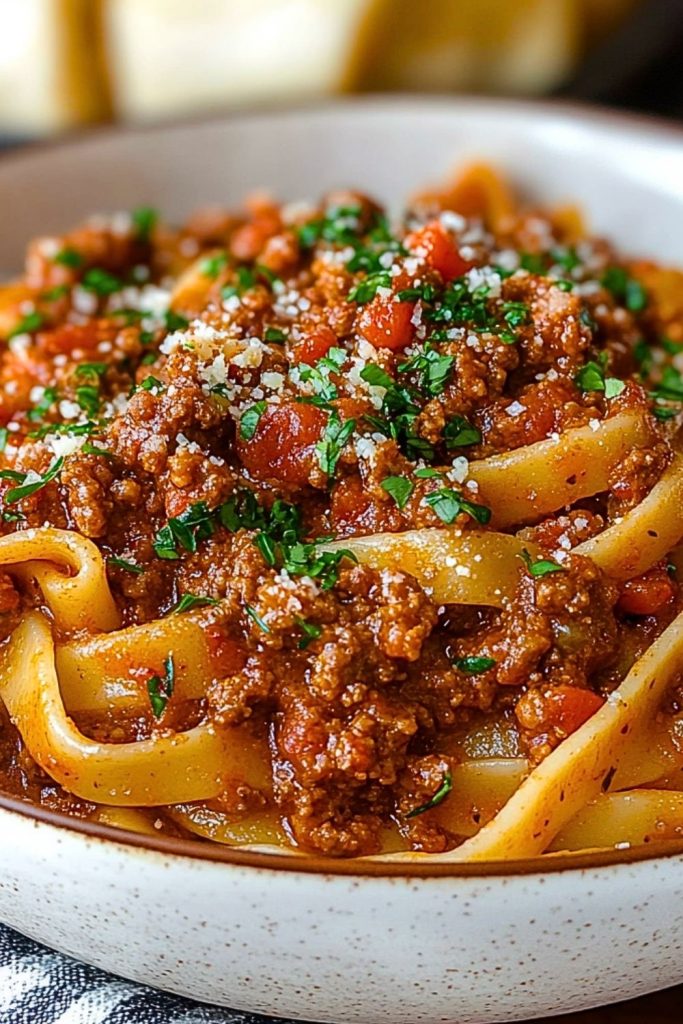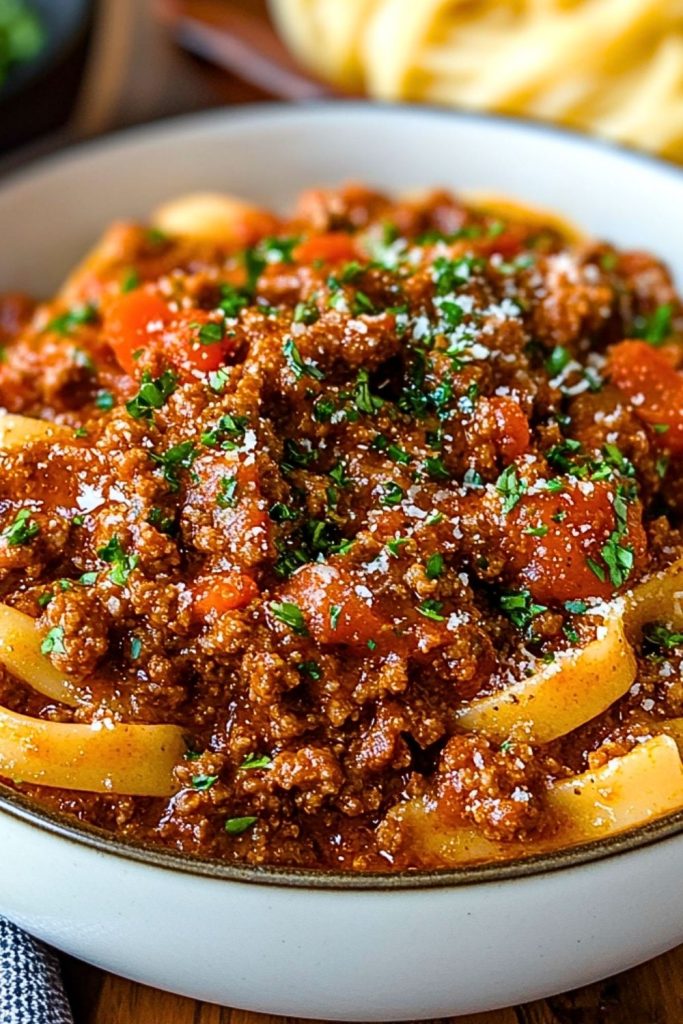When I think about comfort food, few things come to mind faster than a bowl of rich, slow-cooked Bolognese sauce blanketing a nest of al dente pasta. This isn’t just a meat sauce—it’s a celebration of hearty Italian flavors built layer by layer. The depth and complexity of the sauce come from a careful blend of aromatics, quality beef, ripe tomatoes, and a patient simmer that transforms humble ingredients into something unforgettable.

Homemade Bolognese Sauce is my go-to recipe when I want to serve something undeniably delicious yet soul-soothing. Whether I’m hosting a dinner party or just treating myself after a long day, this dish delivers on both flavor and warmth. It’s rustic, it’s cozy, and every bite carries the love and effort that went into preparing it.
Why You’ll Love This Homemade Bolognese Sauce
This Bolognese isn’t your average weeknight meat sauce—it’s deeper, richer, and packed with character. What makes it stand out is the slow cooking process that allows the ingredients to truly meld. You’ll love the balance of the sweetness from the carrots and onions, the boldness of the tomato paste, and the savory magic from a good splash of red wine.
It’s also incredibly versatile—serve it with tagliatelle, spoon it over polenta, or even layer it in a lasagna. It freezes beautifully, so you can make a big batch and have flavorful meals ready to go for weeks. It’s one of those recipes that feels like a gift from your kitchen every time you eat it.
Deep Dive into Bolognese Basics
What Type of Meat Should I Use for Bolognese?
When it comes to the heart of a great Bolognese, the meat choice makes all the difference. I like to use a mix of ground beef and ground pork—typically in equal parts. The beef brings a hearty, meaty flavor, while the pork adds a gentle sweetness and richness thanks to its fat content. If you prefer something leaner, ground turkey can be used, but you may want to bump up the olive oil or butter for richness.
Don’t be tempted to use just lean ground beef. A bit of fat is essential here, both for flavor and to help the sauce achieve that luxurious texture Bolognese is known for.
Options for Substitutions
Bolognese is a dish with strong bones, but it’s forgiving enough to welcome some swaps when needed:
- Meat Alternatives: You can use ground turkey, chicken, or even plant-based meat for a lighter or vegetarian version. Lentils can also be a good protein-packed substitute for a meatless Bolognese.
- Wine: Red wine adds depth, but if you don’t have any on hand (or prefer not to use alcohol), beef broth with a splash of balsamic vinegar or even grape juice can work in a pinch.
- Milk: Traditionally, a small amount of milk or cream is stirred in for smoothness. Plant-based milks like oat or almond can be used, as long as they’re unsweetened.
- Tomatoes: Crushed tomatoes are classic, but canned tomato sauce or even fresh peeled tomatoes can do the job—just adjust for sweetness and acidity.
Flexibility is one of the quiet joys of making Bolognese. As long as you respect the process, you can still get that deep, slow-simmered magic.
Ingredients for Homemade Bolognese Sauce
Each ingredient in Bolognese serves a purpose, contributing to the depth, richness, and harmony of the final sauce. Here’s a closer look at what you’ll need and why it matters:
Ground Beef
This is the core of the sauce, providing the meaty texture and flavor. Choose a blend with some fat (around 80/20) for best results.
Ground Pork
Balances out the beef with its delicate, slightly sweet richness. The fat also helps create a more velvety sauce.
Carrots
They bring a natural sweetness that contrasts beautifully with the acidity of the tomatoes.
Celery
Adds aromatic depth and helps build the classic Italian soffritto base.
Onion
Essential for the flavor foundation. It mellows and sweetens as it cooks down, creating a savory backbone for the sauce.
Garlic
Just a little goes a long way—garlic infuses the sauce with warmth and earthiness.
Tomato Paste
Concentrated tomato flavor that adds richness and a bit of tang. It also helps thicken the sauce.
Crushed Tomatoes
The main tomato base—these break down beautifully and soak up all the meaty, savory notes during the long simmer.
Red Wine
Lends bold flavor and a touch of acidity that cuts through the richness. Also helps deglaze and lift the fond from the pan.
Milk or Cream
Added toward the end to soften the sauce and give it a luxurious, smooth finish.
Olive Oil or Butter
Used for sautéing the vegetables and adding extra richness at the base.
Salt and Pepper
Crucial for seasoning—add in layers throughout cooking to build flavor.
Nutmeg (Optional)
A tiny pinch adds a subtle warmth and classic Italian character.
Fresh Parsley or Basil (Optional Garnish)
For a pop of color and freshness just before serving.

Step-by-Step – How to Make Homemade Bolognese Sauce
Let’s break down the process into clear, simple steps so you can create a Bolognese sauce that tastes like it simmered in a Tuscan kitchen all day.
Step 1: Build Your Flavor Base
Start by heating a generous drizzle of olive oil or a couple of tablespoons of butter in a large, heavy-bottomed pot over medium heat. Add finely chopped onions, carrots, and celery. Cook them slowly until softened—about 8–10 minutes. This aromatic mix, known as soffritto, is the foundation of the sauce.
Step 2: Add the Garlic and Tomato Paste
Stir in minced garlic and cook for another minute until fragrant. Then add the tomato paste and stir it into the vegetables. Let it cook for a couple of minutes to caramelize slightly—this deepens the flavor and gives the sauce a rich color.
Step 3: Brown the Meat
Add the ground beef and pork to the pot. Use a wooden spoon to break it up into small pieces as it browns. Cook until there’s no more pink, and the meat is starting to develop some caramelized bits.
Step 4: Deglaze With Red Wine
Pour in the red wine, scraping the bottom of the pot to release all the delicious browned bits. Let the wine simmer and reduce for about 5 minutes, intensifying the flavor and giving the sauce body.
Step 5: Add Tomatoes and Simmer
Now stir in the crushed tomatoes. Season with salt, pepper, and a pinch of nutmeg if you’re using it. Bring the sauce to a gentle simmer. Reduce the heat to low and let it cook uncovered for at least 1.5 to 2 hours, stirring occasionally. The longer it simmers, the richer it becomes.
Step 6: Finish With Milk or Cream
In the last 15 minutes of cooking, stir in milk or cream. This mellows the acidity and adds a velvety finish. Taste and adjust seasoning if needed.
Step 7: Let It Rest (Optional But Recommended)
Once cooked, let the sauce sit off the heat for about 10 minutes. This gives the flavors a moment to settle and deepen further before serving.
Timing and Tips for Perfect Homemade Bolognese Sauce
How Long to Cook the Bolognese Sauce
Bolognese is a slow-cooked masterpiece—it’s not a dish you rush. The ideal cooking time is 1.5 to 2 hours, though some cooks will go as long as 3 hours for extra depth.
You’ll want the sauce to gently bubble—not boil—and reduce slowly. This allows all the flavors to concentrate and meld beautifully. The meat should be tender, and the sauce thick, with an almost silky texture. Stir occasionally and add a splash of water or broth if it starts to dry out too much during cooking.
Tips for Perfect Bolognese
- Use a heavy-bottomed pot or Dutch oven: This ensures even heat and prevents scorching over long cooking times.
- Go low and slow: Keep the heat low once everything’s added—rushing the simmer will compromise flavor and texture.
- Season in layers: Add a little salt during each stage—when cooking the veggies, browning the meat, and simmering the sauce. It builds a well-rounded flavor.
- Deglaze thoroughly: Don’t skip this! Wine lifts the fond (brown bits) from the bottom of the pot, and that’s where so much flavor lives.
- Milk at the end: Stirring in milk or cream in the final stage balances acidity and gives the sauce that luxurious finish.
- Rest before serving: Even a 10-minute rest before plating allows the sauce to thicken and mellow perfectly.
Avoiding Mistakes and Serving Suggestions for Homemade Bolognese Sauce
Watch Out for These Mistakes While Cooking
Even a timeless dish like Bolognese can go sideways if a few key things are overlooked. Here’s what to avoid:
- Using Too Lean Meat
Fat equals flavor. Ultra-lean ground beef can make your sauce dry and flat-tasting. Aim for a mix of meats or use 80/20 beef.
- Rushing the Cook Time
Bolognese needs a low simmer over time. Boiling it fast can toughen the meat and leave you with a harsh, underdeveloped sauce.
- Skipping the Wine or Not Letting It Reduce
Whether using wine or a non-alcoholic substitute, it’s crucial to let it simmer off to deepen the flavor and cut through the richness.
- Overloading with Tomatoes
This isn’t a marinara sauce. Adding too much tomato can overpower the balance—meat should still be the star.
- Forgetting to Stir Occasionally
During that long simmer, give the sauce some love. Stir every 15–20 minutes to prevent sticking and burning at the bottom.
- Adding Dairy Too Early
Milk or cream should go in near the end. Adding it too early risks curdling and can mute the complexity of the sauce.
- Underseasoning
Taste as you go. A pinch of salt here and there as you layer helps the flavor develop fully without becoming salty.
- Serving It Too Soon
Give it a few minutes off heat to rest. Just like chili or stew, Bolognese improves with a short pause before serving.
What to Serve With Homemade Bolognese Sauce?
Looking to round out the meal? Here are eight delicious ideas that pair beautifully with Bolognese:
1. Fresh Tagliatelle or Pappardelle
The wide, flat ribbons of these pastas are perfect for catching all the rich sauce.
2. Creamy Polenta
A soft, cheesy polenta bed is the ultimate comfort companion to Bolognese.
3. Garlic Bread
Crunchy, buttery, and garlicky—this is perfect for soaking up every last bit of sauce.
4. Green Salad with Balsamic Vinaigrette
A crisp salad with a tangy dressing offers a refreshing contrast to the rich, meaty sauce.
5. Roasted Broccoli or Brussels Sprouts
Charred, slightly crispy greens balance the heartiness of the dish with an earthy bite.
6. A Glass of Bold Red Wine
Think Chianti, Sangiovese, or Barbera—these wines enhance the deep flavors of the sauce.
7. Parmesan Roasted Potatoes
Savory, herby potatoes make a great Bolognese side if you’re skipping pasta.
8. Crusty Artisan Bread
Sometimes all you need is a simple loaf of crusty bread to scoop, dip, and enjoy.
Storage and Nutrition for Homemade Bolognese Sauce
Storage Instructions
One of the best things about Homemade Bolognese Sauce is how well it stores. In fact, it might even taste better the next day after the flavors have had more time to settle and deepen.
- Refrigerator
Let the sauce cool completely before transferring it to an airtight container. It will keep well in the fridge for up to 4–5 days. Reheat gently on the stove or in the microwave, adding a splash of water or broth if it thickens too much.
- Freezer
Bolognese is a freezer hero. Portion it into freezer-safe containers or resealable bags (flattened for easy stacking), and it will last for up to 3 months. Thaw overnight in the fridge before reheating on the stove.
- Batch Cooking Tip
Make a double batch and freeze half for a future quick dinner. You’ll thank yourself later when dinner is ready in minutes.
Estimated Nutrition
Please note, this is a general estimate and can vary depending on the exact ingredients and proportions you use. This breakdown is based on one serving (about 1 cup of sauce made with beef and pork):
- Calories: ~320
- Protein: ~22g
- Fat: ~20g
- Carbohydrates: ~12g
- Fiber: ~3g
- Sugars: ~5g
- Sodium: ~500mg
If you’re watching your intake, you can easily adjust the recipe—use leaner meat, skip the cream, or load it with more veggies to boost fiber and reduce fat.
Frequently Asked Questions & Final Thoughts
Frequently Asked Questions
What’s the difference between Bolognese and regular meat sauce?
Bolognese is richer and more complex. It uses a soffritto base (onions, carrots, celery), a mix of meats, and a long, slow simmer. Regular meat sauce is often tomato-heavy and quicker to make.
Can I make Bolognese in a slow cooker?
Yes, and it turns out beautifully! Brown the meat and sauté the vegetables first, then transfer everything to the slow cooker. Let it simmer on low for 6–8 hours.
What kind of pasta goes best with Bolognese?
Tagliatelle is the traditional choice, but fettuccine, pappardelle, rigatoni, or even gnocchi are all great. Anything that can hold onto that rich sauce works well.
Is it okay to add mushrooms to the sauce?
Absolutely. Mushrooms add a savory, umami note and blend wonderfully with the meat. Sauté them with the vegetables for best flavor.
How can I make it dairy-free?
Skip the milk or cream at the end or use an unsweetened plant-based milk like oat or almond. Be sure it’s unflavored to avoid clashing with the sauce.
Can I freeze Bolognese with pasta mixed in?
You can, but it’s best to freeze the sauce separately and cook fresh pasta when ready to serve. This keeps the texture ideal and avoids mushy noodles.
Do I have to use wine?
Wine adds depth, but it’s optional. You can substitute with beef broth and a splash of balsamic or grape juice to mimic that rich, tangy background flavor.
Why does my sauce taste acidic?
It could be the tomatoes. Try adding a pinch of sugar or a splash of milk at the end to balance the acidity. Letting the sauce simmer longer can also help mellow it out.
Conclusion
Homemade Bolognese Sauce isn’t just a recipe—it’s a slow, savory ritual that turns a handful of simple ingredients into a comforting, flavor-packed dish. Whether you’re spooning it over fresh pasta, layering it in lasagna, or freezing some for later, this sauce is pure kitchen gold.
It’s the kind of dish that makes your home smell amazing and your guests ask for seconds. And now that you know how to master it, you’ve got a true Italian classic in your back pocket—ready to impress, nourish, and satisfy every single time.

Homemade Bolognese Sauce
- Total Time: 2 hours 15 minutes
- Yield: 6-8 servings
Description
When you want a dinner that feels like a warm hug, Homemade Bolognese Sauce is it. This rich and hearty Italian classic is the ultimate comfort food, perfect for everything from weeknight meals to weekend dinner parties. It’s a slow-simmered, flavor-packed meat sauce made with ground beef, pork, vegetables, wine, and tomatoes—deliciously layered over pasta or spooned into a lasagna. Whether you’re looking for a quick dinner idea, a satisfying weekend project, or freezer-friendly meal prep, this easy recipe delivers big flavor with minimal fuss. It’s one of those go-to food ideas you’ll come back to again and again.
Ingredients
- 1 tablespoon olive oil or 2 tablespoons butter
- 1 onion, finely chopped
- 2 carrots, finely chopped
- 2 celery stalks, finely chopped
- 2 garlic cloves, minced
- 2 tablespoons tomato paste
- 1 pound ground beef (80/20)
- 1 pound ground pork
- 1/2 cup red wine (or beef broth with a splash of balsamic vinegar)
- 1 (28-ounce) can crushed tomatoes
- 1/2 cup whole milk or heavy cream
- Salt and freshly ground black pepper, to taste
- Pinch of nutmeg (optional)
- Fresh parsley or basil, for garnish (optional)
Instructions
- In a large heavy-bottomed pot, heat olive oil or butter over medium heat.
- Add onion, carrots, and celery. Sauté until softened, about 8–10 minutes.
- Stir in garlic and cook for 1 more minute. Add tomato paste and cook for another 2 minutes.
- Add ground beef and pork. Cook until browned, breaking up with a spoon.
- Pour in red wine. Scrape the bottom of the pot to deglaze, and simmer until mostly reduced.
- Add crushed tomatoes. Season with salt, pepper, and nutmeg if using. Bring to a simmer.
- Reduce heat to low and simmer uncovered for 1.5 to 2 hours, stirring occasionally.
- Stir in milk or cream in the last 15 minutes. Adjust seasoning to taste.
- Let rest for 10 minutes before serving. Garnish with herbs if desired.
- Prep Time: 15 minutes
- Cook Time: 2 hours

